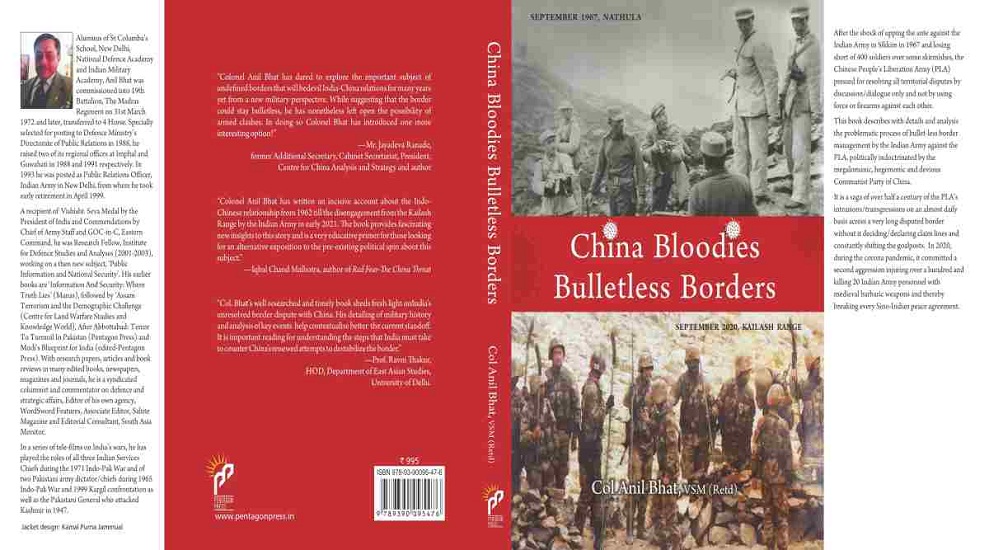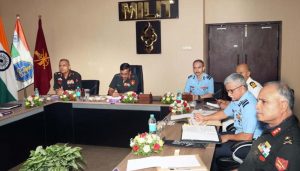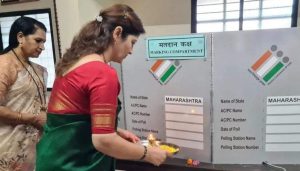The Challenge Of Managing The Unrecognised ‘Bulletles’ Borders

Maj Gen Jagatbir Singh, VSM (Red)
While there have been great strides taken as far as economic linkages between India and China are concerned with bilateral trade of well over a hundred billion dollars with the balance of trade remaining firmly in China’s favour, the undefined borders continue to cause severe strains in our relationship.
The major issue that needs to be resolved between India and China remains the borders or the ‘ perimeters’ as referred to by Kanti Bajpai in his recent book. The centrality of this issue continues to remain uppermost in the minds of all those concerned with policy; be it at the political, diplomatic or military level in addition to analysts and academicians and is the core of ‘ China Bloodies Bulletless Borders’ by Lt Col Anil Bhat.
Lt Col Anil Bhat’ the author of this remarkable book has been part of the Defence Ministry’s Directorate of Public Relations and was also posted as the Indian Army’s Public Relations Officer.
He is also a well-known Defence Analyst and has written numerous books on defence strategic related issues, authored numerous research papers and is presently associated with both Salute Magazine as an Editorial Consultant and is also the Editorial Consultant with South Asia Monitor.
The book itself is divided into seven chapters each dealing with major landmark events between the nations with the focus on developments at the border during the period and the perceptions of both countries.
The author categorically states that post-independence, Prime Minister Nehru conveyed that the nation did not need an army and police forces were sufficient. This may be due to the cultural gap existing as the Army had fought as part of the British forces in World War II and was viewed with suspicion.
Defence Minister Krishna Menon believed ‘that India’s Ordinance factories were better off producing pressure cookers and coffee peculators’. Ill-equipped, insufficiently clad and housed it was poorly tasked while fighting to ‘the last man and last round’ became its hallmark; this is not something that those in command should be proud of as it displayed a total lack of planning at the higher levels of command due to the inability to either reinforce or re-supply the troops in contact.
The author points out the blunder in deciding to go to the UN in 1948. Further, in 1962 we did not use our Air Force, for offensive tasks’ for fear of escalating the situation’. While Krishna Menon was removed as the Defence Minister the ‘pace had been set for India’s powerful bureaucracy to keep the Armed Forces in a stranglehold’.
In 1967, the retaliation by the Indian Army to the Chinese belligerence at both Nathu La and Cho La led to the death of almost 400 hundred PLA soldiers and a large number of bunkers destroyed. This shock resulted in the Chinese pressing for a discussion on all border disputes and asking that no firearms be used against each other. It is a different matter that they often went back to primitive and barbaric means as was evident in Galwan over fifty years later.
The role of Brigadier MMS Bakshi, MVC, the then Brigade Commander at Nathu La has been covered in substantial detail. Undoubtedly he along with General Sagat Singh the Division Commander, who have both repeatedly lead from the front in conflicts; had a major role to play in the display of India’s aggression and seizing the initiative. He had been awarded the Maha Vir Chakra for his exemplary determination, courage and leadership while in command of Hodson’s Horse in the attack on Phillora in 1965; these qualities stood out once again and he shared his experiences and insights regarding Nathu La with the author as both belong to the same Regiment.
Fortunately, permission was given by none other than Prime Minister Indira Gandhi to open up artillery fire and this proved to be a game-changer and heralded a new resolve.
When Brig Bakshi visited Nathu La nearly forty years later in 2005; the wire fencing; the laying of which had sparked the clash in 1967 was still intact and the Chinese ‘wisely refrained from violating it’.
The next incident took place on 20 October 1975 when the PLA killed four riflemen of 5 Assam Rifles after torturing them. This was the battalion that had escorted the Dalai Lama in 1959.
Diplomatic relations were restored with China in 1976 and Mr KR Narayanan was appointed as Ambassador to China and China, in turn, appointed Zhen Zhao Yuan as the Ambassador to India. Shri Atal Behari Vajpayee visited China in February 1979 but had to cut short his visit as China intervened in Vietnam during his visit. However, he did meet his counterpart and also Vice President Deng Xiaoping.
The Chinese Foreign Minister Huang Hua visited India in June 1981 which broke the ice regarding border negotiations, which then began in December 1981 almost two decades after both countries had stopped talking to each other. However, by 1985 the Chinese started showing signs of rigidity and were even evasive on the nature of the way the LAC was to be demarcated and in July 1986 intrusions took place in Sumdrong Chu in Western Arunachal Pradesh.
Unfortunately, over four decades later there has been no progress with reference to resolving the border issue to include disengagement of troops at friction points in spite of over twenty two round of talks by Special Representatives and more recently fifteen rounds of military-level talks in Eastern Ladakh.
The 1993 ‘Agreement on Maintenance of Peace and Tranquillity’ paved the way for the reduction of troops and both countries agreed to ‘resolve the border question ‘ through peaceful and friendly consultations’; ‘ each side was to keep its military forces in the areas along the LAC to a minimum level compatible with the friendly and good neighbourly relations between the two countries’; ‘ work out effective confidence-building measures’ and ‘the two sides to deal with problems through friendly consultations’.
This agreement signed during the visit of Prime Minister PV Narshima Rao came about as a result of a milestone visit by Shri Sharad Pawar, the first visit by a Defence Minister to China in July 1992 when it was agreed to develop academic, scientific, technological and military exchanges between the two countries and when the Chinese emphasised reduction in troop strength due to the prohibitive costs.
It is ironic that nearly thirty years later India is being forced to deploy additional troops due to the Chinese expansionism and belligerence. Having become an economic powerhouse China is now forcing India into spiralling defence expenditure in order to defend its territorial integrity.
In 1996 an’ Agreement on Confidence Building Measures on the LAC’; included reduction of certain weapon platforms, avoiding large scale exercises and relating to air intrusions. In 2003 Prime Minister Atal Behari Vajpayee visited China and the joint declaration stated that ‘the common interests of the two countries outweigh their differences’ and ‘the two countries are not a threat to each other’. Yet despite these diplomatic niceties and even compromises from the Indian side, Chinese coercive tactics have continued.
The major achievement during this period was of course the opening up of the Nathu La border for trade in 2006, this followed the upward revision of ties following the visit of Premier Wen Jiabao in April 2005 which witnessed growing understanding in defence and strategic aspects. The visit of Pranab Mukerjee, then the Defence Minister to China in June 2006 resulted in the signing of a first-ever MoU regarding engagements at the military to military level and he also visited the Lanzhou Military Command which was a significant step in building bilateral trust.
In May 2007, Kiren Rijju spoke regarding Chinese intrusions in Arunachal Pradesh. Despite this India still attempted at stopping the ties from deteriorating and Prime Minister Manmohan Singh visited China in 2008 and signed a ‘Shared Vision for the 21st Century’.
In 2008 following an earthquake, China accepted India’s assistance but yet raised a claim on the Northern tip of Sikkim known as ‘Finger. The pattern persisted; cartographic, diplomatic followed by tactical incursions on the ground. In fact, in 2013, the Chinese had intruded in Eastern Ladakh at a time when External Affairs Minister Salman Khurshid visited China in April 2013 and both countries were discussing a ‘Border Defence Cooperative Agreement’.
It is quite ironic that later that year when Prime Minister Li Keqiang visited India, he referred to India as a ‘strategic partner’ while their nuclear weapons were capable of targeting all corners of India and they were actively providing nuclear technology to Pakistan.
The book also examines the standoff at Doklam and the barbaric incident at Galwan which resulted in India taking a firm stand. Unfortunately, these incidents have exposed the fragilities and strains in our relationship. These events have been analysed in detail in the book.
No doubt it is a very detailed book covering aspects of very vexed and complicated border questions, giving out a historical context, the contours and evolution of the issues confronting both countries and also given a glimpse of the challenges faced by those responsible for maintaining the security and integrity of the lines which are perceived differently by both countries and the nature of this inhospitable, difficult and barren terrain. The fact remains that stability in our relations can only manifest itself on the bedrock of settled borders and not trade and commerce.
The book is highly recommended for those who wish to understand the military and border dimensions of India- China relations. Unfortunately, the peace and tranquillity on the border which is what India is wanting and is imperative for both development and prosperity have eluded us as mistrust still dominates the narrative between the two countries.
Unfortunately, the LAC cannot be resolved without China declaring its claim lines. It seems uninterested in doing so as it is obsessed with consolidating military gains by salami-slicing, frequent transgressions and aggressive expansionist behaviour. However, apart from the land, there is no doubt the Chinese larger interests also lie in controlling the waters that flow through the area and the minerals that exist.








